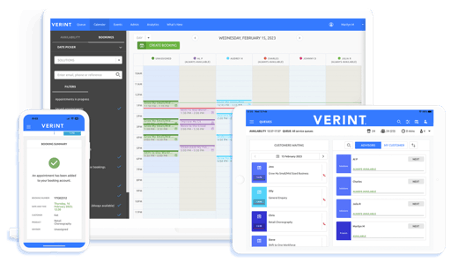What Are the 8 Different Types of Appointment Scheduling


Appointment Scheduling Software allows retailers to offer their customers a fast, simple and engaging way to book appointments for service in-store or online.
Retailers that implement this software can increase footfall traffic to their stores, boost conversion rates (both in-store and online) and improve the customer experience.
There are many different types of appointments retailers and other organizations can use an Appointment Booking Software for. Here are 8 of the most common appointment booking types are:
- Time-slot scheduling
- Wave scheduling
- Wave and walk-in appointment scheduling
- Open appointment scheduling
- Double scheduling
- Cluster scheduling
- Matrix scheduling
- 40/20 scheduling
1. Time-slot scheduling
The most common booking type is time-slot scheduling, otherwise referred to as stream scheduling. Essentially, time-slot or stream scheduling is when a customer is provided with a list of available time-slots to choose from.
The customer clicks on the time-slot that suits them, fills out their details and receives a confirmation email and/or SMS as a follow up.
Pros
- Customers can select a precise time slot that’s most convenient
- Retailers have the ability to control which slots are available on which days using the stream scheduling method
Cons
- If customers book up quickly, there may not be any free spaces for other customers
- Late-arriving appointment customers and appointments that take longer than expected may delay the schedule for the rest of the day

2. Wave scheduling
Another different scheduling type is wave scheduling, where customers essentially arrive in waves at certain times throughout the day and are served in the order at which they arrive.
For instance, you might have five customers coming in-store every half hour or hour and a customer host assigns them to the next available consultant or associate. This is a great way to stagger customer visits throughout the day, which is useful when your customer journey demands that you prioritize customers with urgent needs over others.
Pros
- Useful when predicting uptake and organizing resources for key services
- Adaptable and flexible to your business needs
Cons
- Consumers may walk out if there’s a limited spaces
3. Wave scheduling + walk-in
Another approach to the above wave scheduling technique is to schedule customers at specific times during the first half of each hour, and keep the second half-hour open for walk-in customers or who require urgent care.
This way you can prioritize those with appointments first, or those with urgent needs, and then for the rest of the hour your team can see walk-in customers.
Another approach to the wave scheduling system is to schedule appointments that are expected to take longer on the hour and to schedule shorter appointments on the half-hour.
Pros
- Supports appointment and walk-in customers
- Store associates can organize appointments based on customer priority
Cons
- Deciding whether walk-in or appointment customers should be served first can be tricky
4.Open booking
Another approach is to have open booking scheduling, where customers aren’t given a specific time for their appointment but are told to come in during a specific time range, such as between 10am and 12pm. The customers are served in the order of their arrival. Open booking works best when there is a constant stream of customers or when a store is not busy.
Pros
- Doesn’t involve any admin
- Entirely adjustable appointment times
Cons
- Difficult to forecast foot traffic or collect data
- Risk that customers all come at a particular time resulting in long wait lines for service
- Store managers can’t control their teams schedules
5. Double scheduling
Essentially, double scheduling, which is a slightly different appointment type, consists of allowing two customers to make an appointment at once. This is when a retailer allows customers to arrive at the same appointment time and are both scheduled into a single time slot. This is sometimes used when customers have urgent needs and must be added to an already-full schedule.
Potential workarounds are having other sales associates available to take additional bookings or offering virtual bookings instead.
Pros
- May increase brand loyalty as customers are grateful when they feel you’ve gone the extra mile to support them
- Can take even more business
Cons
- Risk of overstraining your staff and services
- Store teams will need training to learn how to handle customers in such situations
6.Cluster scheduling
Cluster scheduling consists of allocating customers with similar service needs consecutive appointments on a particular day. This is often the scheduling system of choice by physicians, doctors and nurses because they can help patients quickly.
Think of cluster scheduling as the equivalent of an assembly line–service providers can give multiple patients with simple needs the same support again and again, speeding up the process.
Pros
- Quicker and more efficient service for a group of customers
- Increased control over associate schedules
Cons
- Customers don’t have as much freedom to schedule an appointment on a day of their choosing
- Associate schedules can overfill if there’s no cap on appointments
7. Matrix scheduling
Contrary to popular belief, matrix scheduling isn’t the art of letting customers watch Keanu Reeves save the virtual world in a trench coat. A matrix scheduling system works a lot like a standard appointment calendar, except that it usually contains at least two different organizing principles.
For example, you may have your store associates calendars mapped onto a schedule highlighting which resources are available at which times. To make a matrix schedule easier to look at, it’s also commonplace to include symbols such as ticks and crosses.
Pros
- You can cross-reference which associates and resources are available at certain times
- Improves company-wide communications because you can map one departments’ schedule against another’s
Cons
- Matrix scheduling often overcomplicates associate calendars for those who work between departments
8. 40/20 scheduling
Essentially, the 40/20 appointment model is a method businesses use to streamline the customer journey when multiple associates need to serve each customer. Traditionally, one associate serves the first customer on the hour, the second after 20 minutes, and the third after 40 minutes, on a cycle.
For example, if an optician needs to give a consumer an eye test before passing them to a sales representative for personalized styling advice, they may well use the 40/20 appointment model.
Pros
- Ensures the customer doesn’t have to wait for a long time between appointments with multiple associates
- Maximizes the number of customers that receive service
Cons
- If appointments overrun, the 40/20 appointment model can quickly disentangle and customers may get frustrated about waiting
Conclusion
When choosing an Appointment Booking System, it’s worth making sure it is available across multiple store locations and regions, so that the system is fully integrated and head office and in-store teams are in-sync. It’s also worth finding a booking system that has multiple languages, especially if you’re a global business.
Interested to find out how Verint’s clients are using appointment scheduling to boost sales, loyalty and brand awareness? Read our case studies for Samsung and Specsavers.